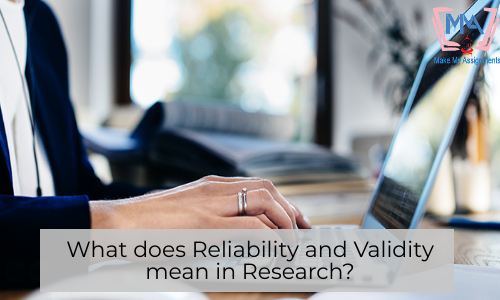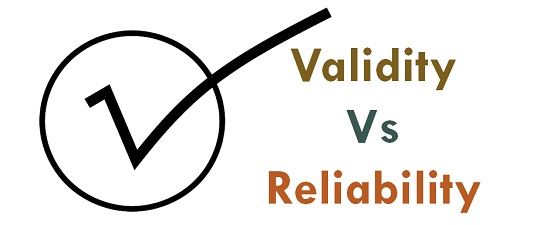
In this method, the researcher performs a similar test over some time. The 4 different types of reliability are: 1. Different types of Reliability.
Research reliability can be The term reliability in psychological research refers to the consistency of a research study or measuring test. A specific measure is considered to be reliable if its application on the same object of measurement number of times produces the same results. Validity is the degree to which the researcher actually measures what he or she is trying to measure.In simple terms, research reliability is the degree to which research method produces stable and consistent results. Reliability means that the results obtained are consistent. Accurate results are both reliable and valid.
Target A shows a measurement that has good reliability, but has poor validity as the shots are consistent, but they are off the center of the target. The shots are neither consistent nor accurate. In the illustration below, Target B represents measurement with poor validity and poor reliability. In general, validity refers to the legitimacy of the research and its conclusions: has the researcher actually produced results that support or refute the.Reliability and validity are often compared to a marksman's target. The same analogy could be applied to a tape. Scales which measured weight differently each time would be of little use.
They are inherently unpredictable and transitory. Random errors in measurement are inconsistent errors that happen by chance. Specificity and sensitivity are measures of how accurate a test is, which validity is.Random Errors: Random error is a term used to describe all chance or random factors than confound—undermine—the measurement of any phenomena. The main focus of reliability is on how consistent a measure is while the focus of validity is on a measure’s accuracy.
In essence, it is how well a test or piece of research measures what it is intended to measure. As the number of random errors decreases, reliability rises and vice versa.Validity is defined as the extent to which a measure or concept is accurately measured in a study. The amount of random errors is inversely related to the reliability of a measurement instrument.
Concept Of Validity And Reliability In Research Free From Random
The risk of unreliability is always present to a limited extent.Here are the basic methods for estimating the reliability of empirical measurements: 1) Test-Retest Method, 2) Equivalent Form Method, and 3) Internal Consistency Method. But, due to the every present chance of random errors, we can never achieve a completely error-free, 100% reliable measure. Reliability is the degree to which a measure is free from random errors. As systematic errors increase, validity falls and vice versa.As stated above, reliability is concerned with the extent to which an experiment, test, or measurement procedure yields consistent results on repeated trials. The amount of systematic error is inversely related to the validity of a measurement instrument. Here are two everyday examples of systematic error: 1) Imagine that your bathroom scale always registers your weight as five pounds lighter that it actually is and 2) The thermostat in your home says that the room temperature is 72º, when it is actually 75º.
Second, the first and second tests may not be truly independent. First, it may be difficult to get all the respondents to take the test—complete the survey or experiment—a second time. Reliability is equal to the correlation of the two test scores taken among the same respondents at different times.There are some problems with the test-retest method. If the results of the two tests are highly consistent, we can conclude that the measurements are stable and reliability is deemed high. The goal of the test-retest method is to uncover random errors, which will be shown by different results in the two tests. The second test is typically conducted among the same respondents as the first test after a short period of time has elapsed.
First, it can be very difficult—some would say nearly impossible—to create two totally equivalent forms. If there is a strong correlation between the instruments, we have high reliability.The equivalent form method is also not without problems. Both instruments are given to the same sample of people. With this method, the researcher creates a large set of questions that address the same construct and then randomly divides the questions into two sets. The equivalent form method measures the ability of similar instruments to produce results that have a strong correlation. And, third, environmental or personal factors could cause the second measurement to change.Equivalent Form Method: The equivalent form method is used to avoid the problems mentioned above with the test-retest method.

There are several different types of validity in social science research. Chronbach's alpha is also called the coefficient of reliability.Validity is defined as the ability of an instrument to measure what the researcher intends to measure. If this condition cannot be met, other statistical analysis should be considered. Cronbach's alpha technique requires that all items in the scale have equal intervals. A lack of correlation of an item with other items suggests low reliability and that this item does not belong in the scale.

Predictive Validity refers to the usefulness of a measure to predict future behavior or attitudes. The SAT test, for instance, is said to have criterion validity because high scores on this test are correlated with a students' freshman grade point averages.There are two types of criterion validity: Predictive Validity and Concurrent Validity. It measures the match between the survey question and the criterion—content or subject area—it purports to measure. To establish content validity, we must review the literature on the construct to make certain that each dimension of the construct is being measured.Criterion Validity: Criterion Validity measures how well a measurement predicts outcome based on information from other variables. If we are constructing a test of arithmetic and we only focus on addition skills, we would clearly lack content validity as we have ignored subtraction, multiplication, and division. To establish content validity all aspects or dimensions of a construct must be included.



 0 kommentar(er)
0 kommentar(er)
